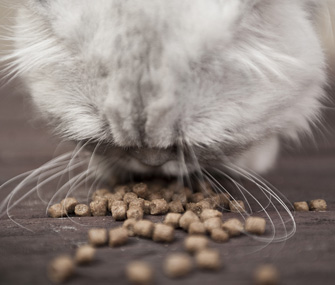Got a Fat Cat? Here Are 7 Simple Ways to Help Your Cat Lose Weight
Published on March 25, 2014

Nevertheless, I’m here to tell you that your cats can be trimmer, happier and healthier if you follow these seven “simple” steps:
Step 1: Enact portion control measures. (No more bottomless bowls of kibble!)
Now, I understand that this can be hard to do. Especially when you’ve got multiple cats swirling about your feet pleading vociferously for more. But trust me… this too shall pass.
Note: Reducing the quantity of food too rapidly can lead to a serious disorder called hepatic lipidosis (fatty liver disease). Obese cats are especially predisposed to this condition. Always ask your veterinarian for advice on how much to feed, especially when it comes to weight loss.
Step 2: Feed cats in separate spaces. This decreases “stealing” behavior, reduces resource-related inter-cat anxieties, and encourages a more relaxed approach to feeding time.
Step 3: Feed wet foods. An increasing cache of evidence suggests that wet or even moistened kibble diets can increase activity levels and lead to weight loss.
The theories behind this differ, but activity levels seem to rise when cats consume water within their meals. Which kind of makes sense when you think about it. After all, cats were originally desert creatures who had little available sources of water and ate their prey whole, blood and all. (I know, I know, it’s gross.)

Step 4: Feed smaller meals more times a day. A new study advances the notion that more frequent meals means cats move more in advance of their feedings. Makes sense seeing as petite prey is what smaller wild cats tend to consume.
Step 5: Schedule feedings. Since it’s been proposed by the authors in the above-referenced article that multiple feedings make cats move, it follows that adhering to scheduled feeding times means they know just when to get a move on.
Step 6: Consider the sterilization effect. There’s new evidence to suggest that our cats’ metabolisms slow down dramatically in the first few months after sterilization. This, my dear feline-loving readers, is the time to start implementing portion-control measures! Ask your veterinarian to guestimate your cat's ideal caloric intake. It will almost certainly be less than what he or she has been eating thus far.
Step 7: Exercise! The honest truth is that cats who live an indoor/outdoor lifestyle are less likely to be overweight or obese. But that’s not to say I’m advocating out-of-doors living. After all, indoor-only cats are safer from trauma, less disease-prone, and not as likely to kill sensitive species. But that doesn’t mean indoor cats can’t be motivated to exercise.
Try fishing-line-type toys, laser pointer devices, throwing low-cal treats across the room (frozen peas and corn have worked for me in the past), and hiding tiny bits of nibbles around the house so that even indoor cats can experience the thrill of the “hunt.”
There's No Excuse
Now that you have the evidence in hand, will you comply? Interestingly, most of my fat cat owners won't. What's up with that?
Here are a few of the reasons they cite for failing to follow these veterinary recommendations, accompanied by my responses:
Them: I have too many cats to feed them separately.
Me: OK, so unless you live in an urban micro space, you at least have a bathroom, a bedroom and a living area, right? And if you don’t have three rooms, you probably shouldn’t have more than three cats, anyway. (That’s just my opinion.) So it shouldn’t be so hard to get everyone to adhere to the habit of eating alone.
Them: My cats don’t like wet food.
Me: The unfortunate fact is that many cats are “kibble-addicted.” Nonetheless, it’s possible to encourage wet food consumption by gradually moistening the dry diets with a strong, low-sodium beef or chicken stock. (I buy super-cheap organ meats expressly for this purpose.)
And let’s be honest: You probably wouldn’t have had any trouble had you employed wet food practices when they were kittens. Starting them off young is always a great idea.
Them: They steal each other's food.
Me: Watch them while they eat. Feed them in separate rooms. Pick up the bowls when they’re done. If they leave any behind, be sure to remove the remainder. They’ll eat more later if they’re still hungry.
Cats Deserve Attention Too
All of the above makes perfect sense to me. But then, not everyone has the luxury of a highly scheduled lifestyle and a lot of time to devote to their cats. I mean, cats are America’s most popular pets predominantly because they’re considered so “low-maintenance.”
Yet in defiance of popular opinion, I’ll propose here that feline welfare is not best served by a hands-off approach to their care. After all, pets are hard work! And just because they appear so independent doesn’t mean they deserve any less attention than our much-beloved but more demanding dogs.
More on Vetstreet.com:





